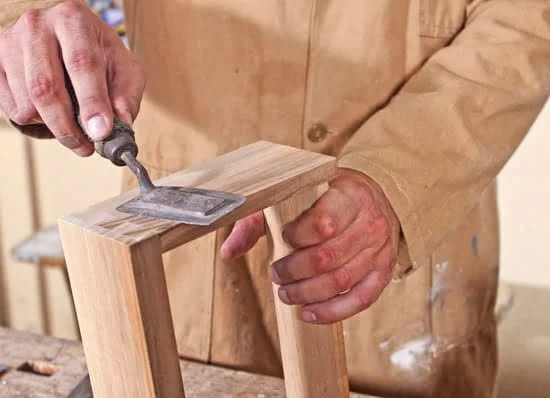Woodworkers rely heavily on a variety of tools to bring their woodworking projects to life, and among the most essential are clamps. Clamps play a crucial role in holding pieces together, providing support, and ensuring accuracy during glue-ups. These versatile tools come in various types, sizes, and functions, making them indispensable for woodworkers of all skill levels. In this article, we will delve into the world of clamps and answer the question: how many clamps should a woodworker have?
When it comes to woodworking, having the right tools can make all the difference in the outcome of a project. Clamps are no exception – they provide stability and control that is necessary for achieving precise results in woodworking tasks.
From bar clamps to pipe clamps and spring clamps, each type serves a unique purpose in securing pieces during assembly, glue-ups, or even when working with delicate materials. Understanding the different types of clamps available can help woodworkers choose the right tool for the job at hand.
In addition to knowing the types of clamps available, woodworkers must also consider the quantity needed for their projects. The number of clamps required can vary depending on the size and complexity of the project. Having an adequate supply of clamps ensures that pieces are held securely in place throughout the construction process and improves overall workflow efficiency. Let’s explore further into the functions, sizes, and quantities of clamps needed to enhance your woodworking experience.
Types of Clamps
Bar clamps, pipe clamps, and spring clamps are essential tools in a woodworker’s arsenal, each serving specific purposes and offering unique benefits. Understanding the different types of clamps available can help woodworkers choose the right tool for the job and enhance the quality of their woodworking projects.
Bar Clamps
Bar clamps are versatile tools that can exert significant pressure to hold pieces of wood together during glue-ups or assemblies. They typically consist of a long bar with adjustable jaws that can be extended to accommodate various project sizes. Bar clamps are popular among woodworkers due to their ease of use and ability to provide even pressure across a wide surface area.
Pipe Clamps
Pipe clamps are another common type of clamp used in woodworking, consisting of two key components: a length of pipe and two adjustable jaw ends. The pipe acts as the main body of the clamp, while the adjustable jaw ends can be moved along the pipe to secure workpieces. Pipe clamps are known for their affordability and flexibility, making them suitable for a wide range of woodworking applications.
Spring Clamps
Spring clamps are compact and lightweight tools that are ideal for temporary holding tasks in woodworking. These small but mighty clamps feature spring-loaded jaws that can be easily squeezed open and closed with one hand. Spring clamps are perfect for securing small parts or delicate pieces during intricate woodworking processes where other types of clamps may be too cumbersome or overpowering.
Functions of Clamps
Holding Pieces Together
One of the primary functions of clamps in woodworking is to hold pieces together firmly during various stages of a project. Whether it’s joining two boards for edge-gluing or securing parts in place for assembly, clamps play a crucial role in ensuring that the pieces stay in position until the adhesive dries or the joinery is complete.
Without the use of clamps, woodworkers would struggle to achieve tight and secure connections between components, leading to weak joints and misaligned pieces.
Providing Support
Another important function of clamps is to provide support and stability to workpieces while they are being worked on. For example, when routing or sanding a piece of wood, clamps can be used to secure it to a workbench or table, preventing it from moving and ensuring safe and accurate results. Additionally, clamps can also be utilized to hold auxiliary fences or guides in place for more precise cutting and shaping tasks, enhancing overall work quality and efficiency.
Ensuring Accuracy During Glue-Ups
During glue-ups, where multiple pieces of wood are joined together using adhesive, clamps are indispensable tools for ensuring accuracy and proper alignment. By applying even pressure across the glued surfaces, clamps help eliminate gaps between the pieces and prevent them from shifting or moving as the glue sets.
This results in stronger bonds between the wood components and ultimately leads to better-finished products with clean lines and seamless connections. Understanding how many clamps a woodworker should have on hand for different size projects is crucial for achieving successful glue-ups every time.
Clamp Sizes
Clamps are indispensable tools for any woodworker, playing a crucial role in various woodworking tasks. When it comes to choosing the right size of clamps for different projects and materials, it is essential to consider factors such as the size of the workpiece, the pressure needed for the task, and the type of material being worked on. Having an assortment of clamp sizes in your toolkit can make a significant difference in the quality and efficiency of your woodworking projects.
One key consideration when selecting clamp sizes is the thickness of the material you are working with. For thinner materials, smaller clamps may be sufficient to hold pieces together securely without causing damage. On the other hand, larger and heavier materials will require larger clamps with greater gripping capacity to ensure stability during assembly or glue-ups. Understanding how different clamp sizes correspond to various project requirements is essential for achieving precise and professional results in woodworking.
In general, woodworkers should aim to have a diverse selection of clamp sizes in their collection to accommodate a wide range of project needs. While there is no one-size-fits-all answer to how many clamps a woodworker should have, having at least a few small, medium, and large clamps can provide versatility for different tasks. Additionally, specialty clamps like corner clamps or band clamps can be useful additions for specific projects that require unique holding or securing solutions.
| Clamp Size | Ideal Use |
|---|---|
| Small Clamps | Suitable for thinner materials or delicate pieces |
| Medium Clamps | Versatile size for a wide range of projects |
| Large Clamps | Necessary for heavy-duty applications and larger workpieces |
Quantity of Clamps
Woodworkers rely heavily on clamps to hold pieces together during projects, provide support, and ensure precision in their work. The question of how many clamps a woodworker should have in their toolkit is a common one, and the answer largely depends on the size and complexity of the projects they undertake. Having an adequate number and variety of clamps can significantly impact the quality of woodworking outcomes.
When determining how many clamps to have, woodworkers should consider factors such as the scale of their projects, the materials being used, and the techniques involved. For smaller projects that involve delicate or intricate pieces, having a selection of smaller clamps like spring clamps or hand screw clamps can be beneficial. On the other hand, larger projects may require a more substantial number of bar clamps or pipe clamps to handle heavier pieces and provide sufficient pressure during glue-ups.
It is advisable for woodworkers to start with a basic collection of essential clamps such as bar clamps, C-clamps, and spring clamps. As woodworkers progress in their craft and take on more complex projects, they can expand their clamp collection accordingly.
It’s also beneficial to have a few specialty clamps like band clamps or strap clamps for specific tasks such as frame assembly or edge-gluing. Ultimately, having a diverse range of clamp sizes and types will equip woodworkers to handle various woodworking challenges with confidence.
| Clamp Type | Quantity |
|---|---|
| Bar Clamps | 6-10 |
| C-Clamps | 4-6 |
| Spring Clamps | 8-12 |
Clamping Techniques
Woodworkers rely heavily on clamps for holding pieces together during various woodworking tasks, ensuring precise and accurate results. When it comes to selecting the right type of clamp for a project, woodworkers have a wide range of options to choose from. Some of the most common types include bar clamps, pipe clamps, spring clamps, and more. Each type offers its own unique advantages and is suitable for different applications.
In order to achieve strong and seamless joints in woodworking projects, understanding the functions of clamps is crucial. Clamps not only hold pieces together during glue-ups but also provide support and help maintain alignment. For tasks like edge-gluing or panel glue-ups, having the right clamping technique can make all the difference in achieving a professional-looking result. Properly using clamps can also be essential during cabinet assembly to ensure that all parts come together accurately.
When determining how many clamps a woodworker should have in their toolkit, several factors come into play. The size and complexity of projects will dictate the quantity required. It is recommended that woodworkers have a variety of clamp sizes on hand to accommodate different project needs effectively. Ensuring that there are enough clamps available for simultaneous glue-ups or assembly tasks can streamline workflow and improve efficiency.
- Consider having at least 12-16 medium-sized clamps for average-sized projects
- Invest in a few larger clamps for heavier tasks or larger assemblies
- Having a selection of smaller clamps can be handy for intricate work or delicate pieces
By following these recommendations and understanding how to properly utilize clamps in woodworking projects, woodworkers can enhance their craftsmanship and produce high-quality results consistently. Regular maintenance of clamps, such as cleaning and lubricating them appropriately, will also prolong their lifespan and ensure they continue to perform effectively over time. With quality clamps being considered valuable investments in the woodworking world, having the right quantity and types of clamps can significantly impact the outcome of projects.
Maintaining Clamps
Clamps are essential tools for any woodworker, as they play a crucial role in holding pieces together, providing support, and ensuring accuracy during glue-ups. However, just like any other tool, clamps require proper maintenance to ensure their longevity and optimal performance. By keeping your clamps clean and well-lubricated, you can extend their lifespan and avoid potential issues that may arise from neglecting their care.
To maintain your clamps effectively, here are some key steps to follow:
- Regular Cleaning: After each use, make sure to clean your clamps using a dry cloth to remove any dust, dirt, or debris that may have accumulated on them. For stubborn grime or glue residue, use a mild detergent or solvent recommended by the clamp manufacturer.
- Lubrication: Periodically lubricate the moving parts of your clamps with a light machine oil or silicone spray to ensure smooth operation. Avoid using heavy oils or greases that may attract more dirt and gunk over time.
- Storage: Store your clamps in a dry environment away from moisture to prevent rusting. Hang them on a rack or place them in a designated toolbox organized by size and type for easy access.
Properly maintaining your clamps not only prolongs their lifespan but also improves their overall performance when working on woodworking projects. By taking the time to care for your clamps regularly, you can ensure that they remain reliable tools in your workshop for years to come.
Remember, quality tools like clamps are investments in your craft as a woodworker. By treating them with care and performing routine maintenance tasks, you can maximize their utility and enjoy the benefits of precision and efficiency in your woodworking endeavors for how many clamps should a woodworker have to come.
Clamps as Investments
In conclusion, the number of clamps a woodworker should have in their toolkit ultimately depends on the size and complexity of their projects. It is recommended to have a variety of clamp types, including bar clamps, pipe clamps, and spring clamps, to ensure versatility in woodworking tasks. When determining how many clamps to acquire, woodworkers should consider the scale of their projects and the materials being used.
Furthermore, investing in quality clamps is crucial for ensuring longevity and improving the overall quality of work. While it may require a higher upfront cost, premium clamps can withstand heavy use and provide reliable performance for years to come. Proper maintenance, such as regular cleaning and lubrication, can also extend the lifespan of clamps and ensure that they function effectively.
Overall, understanding the functions of different types of clamps, choosing the right sizes for specific projects, and utilizing proper clamping techniques are essential aspects of mastering woodworking skills. By having a sufficient quantity of high-quality clamps in their arsenal and taking care of them diligently, woodworkers can enhance their craftsmanship and achieve better results in their creations.
Frequently Asked Questions
Do You Need Clamps for Woodworking?
Clamps are essential tools in woodworking because they help to hold pieces of wood together firmly during the gluing process. They provide pressure and stability, ensuring that your project is assembled accurately and securely.
How Far Apart Should Clamps Be?
The spacing of clamps during woodworking depends on the size and weight of the project. Generally, clamps should be evenly distributed along the length of the workpiece to prevent warping or bending. It is recommended to place clamps about 6-8 inches apart for optimal pressure distribution.
Can You Ever Have Enough Clamps?
In woodworking, it often seems like you can never have enough clamps. Having a variety of clamp sizes and types allows you to tackle different projects effectively. It is common for woodworkers to collect a wide range of clamps over time as each serves a specific purpose in securing various shapes and sizes of wood pieces together.

Hi everyone! I’m a woodworker and blogger, and this is my woodworking blog. In my blog, I share tips and tricks for woodworkers of all skill levels, as well as project ideas that you can try yourself.





